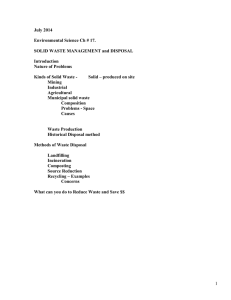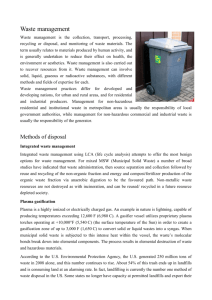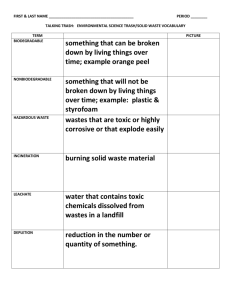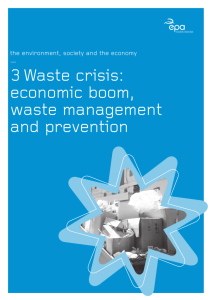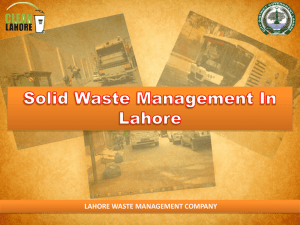Guide to waste disposal techniques and terminology
advertisement
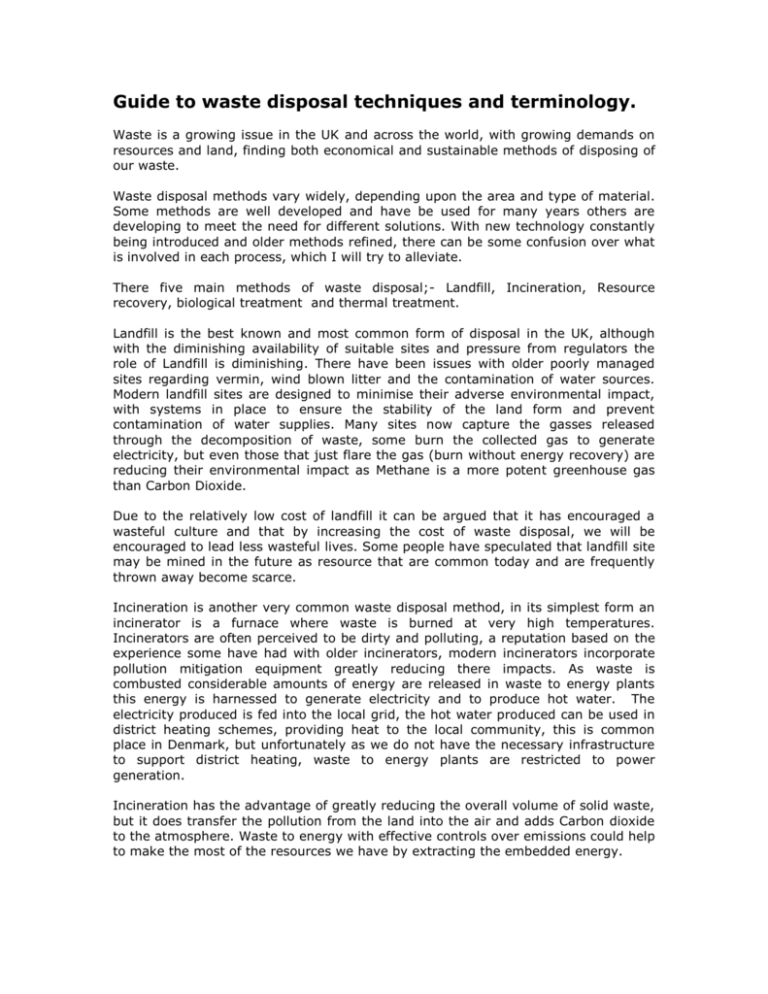
Guide to waste disposal techniques and terminology. Waste is a growing issue in the UK and across the world, with growing demands on resources and land, finding both economical and sustainable methods of disposing of our waste. Waste disposal methods vary widely, depending upon the area and type of material. Some methods are well developed and have be used for many years others are developing to meet the need for different solutions. With new technology constantly being introduced and older methods refined, there can be some confusion over what is involved in each process, which I will try to alleviate. There five main methods of waste disposal;- Landfill, Incineration, Resource recovery, biological treatment and thermal treatment. Landfill is the best known and most common form of disposal in the UK, although with the diminishing availability of suitable sites and pressure from regulators the role of Landfill is diminishing. There have been issues with older poorly managed sites regarding vermin, wind blown litter and the contamination of water sources. Modern landfill sites are designed to minimise their adverse environmental impact, with systems in place to ensure the stability of the land form and prevent contamination of water supplies. Many sites now capture the gasses released through the decomposition of waste, some burn the collected gas to generate electricity, but even those that just flare the gas (burn without energy recovery) are reducing their environmental impact as Methane is a more potent greenhouse gas than Carbon Dioxide. Due to the relatively low cost of landfill it can be argued that it has encouraged a wasteful culture and that by increasing the cost of waste disposal, we will be encouraged to lead less wasteful lives. Some people have speculated that landfill site may be mined in the future as resource that are common today and are frequently thrown away become scarce. Incineration is another very common waste disposal method, in its simplest form an incinerator is a furnace where waste is burned at very high temperatures. Incinerators are often perceived to be dirty and polluting, a reputation based on the experience some have had with older incinerators, modern incinerators incorporate pollution mitigation equipment greatly reducing there impacts. As waste is combusted considerable amounts of energy are released in waste to energy plants this energy is harnessed to generate electricity and to produce hot water. The electricity produced is fed into the local grid, the hot water produced can be used in district heating schemes, providing heat to the local community, this is common place in Denmark, but unfortunately as we do not have the necessary infrastructure to support district heating, waste to energy plants are restricted to power generation. Incineration has the advantage of greatly reducing the overall volume of solid waste, but it does transfer the pollution from the land into the air and adds Carbon dioxide to the atmosphere. Waste to energy with effective controls over emissions could help to make the most of the resources we have by extracting the embedded energy. Resource recovery covers any method that removes usable materials from the waste stream, more commonly referred to as recycling. Resource recovery requires the waste to be separated by either the producer or by the processor, separation and sorting can be by hand or by machine. Most municipal recycling schemes require householders to carry out a pre-sort of our waste, only placing those materials that the authority can recycle into the recycling container , some schemes carryout a further sort at the kerb side with others separating the various components of the recycling stream at a central depot either by hand or machine. Mechanical separation relies the differing properties of each component within the waste stream, such as using magnets to remover Ferris metals, the process Known as Mechanical and Biological Treatment or MBT is a combination of Mechanical sorting to remover the Recyclable materials followed by some form of biological treatment of the remaining organic content. Recycling not only recovers reusable materials for reuse, but has the added environmental benefit of reducing the need for the use of virgin materials and therefore the environmental impact associated with the extraction and processing of these materials. It usually requires less energy, water and other resources to recycle materials than to produce new ones. For example recycling steel saves about 95% of the energy used to refine virgin ore and every ton of Aluminium recycled saves 5 tons of Bauxite being mined. It is important that we assist in the process by ensuring that all of the materials we are sending to be recycled are clean and that we only place those items that our authorities do recycle into the containers as contamination leads to a greater use of energy and therefore a greater environmental impact. Biological treatment can be separated into aerobic decomposition and anaerobic digestion methods. Aerobic decomposition is the process that takes place in any domestic compost heap, with the organic waste being broken down by various organisms in the presence of oxygen. Anaerobic digestion makes use of micro organisms to breakdown waste in an enclosed environment without the presence of oxygen, anaerobic digestion has been in use for may years as part of sewage treatment, it is only been recently explored as a possible solution to domestic organic waste. With anaerobic digestion the waste is reduced into Biogas which can be burned to produce electricity (it is often used as a heat source in the digestion process), a stable organic solid, and a liquid that is rich in nutrients. Both of these processes turn organic waste into usable products but the quality of which is highly dependent on the material going and strict control over contamination needs to be maintained. Composting has the advantage that the general public can do this at home but its efficiency is dependent upon the prevailing weather conditions. Lastly thermal treatment of waste covers any method that uses heat at the core of the process, incineration is a thermal treatment method, others being Pyrolysis and Gasification. Pyrolysis is the chemical decomposition of organic materials in the absence of oxygen, Pyrolysis has three products, a solid residue that can be further refined, a gas and liquid oil both of which can be burnt to produce energy or further refined into usable products. Gasification can be used to convert plastic rich waste into a gas for use as a fuel, this process has been in use for many years converting carbon rich solids and liquids into gas, an example would be the production of Town gas in the 19th century from coal. Both of these techniques are relative new when applied to waste treatment, and therefore carry the extra risk associated with new technologies, but both could have a role to play in waste management. With all of these methods of waste management there are impacts and products that need to be considered. Some require the input of significant amounts of energy others require the careful monitoring of the waste stream to prevent contamination of end products.

